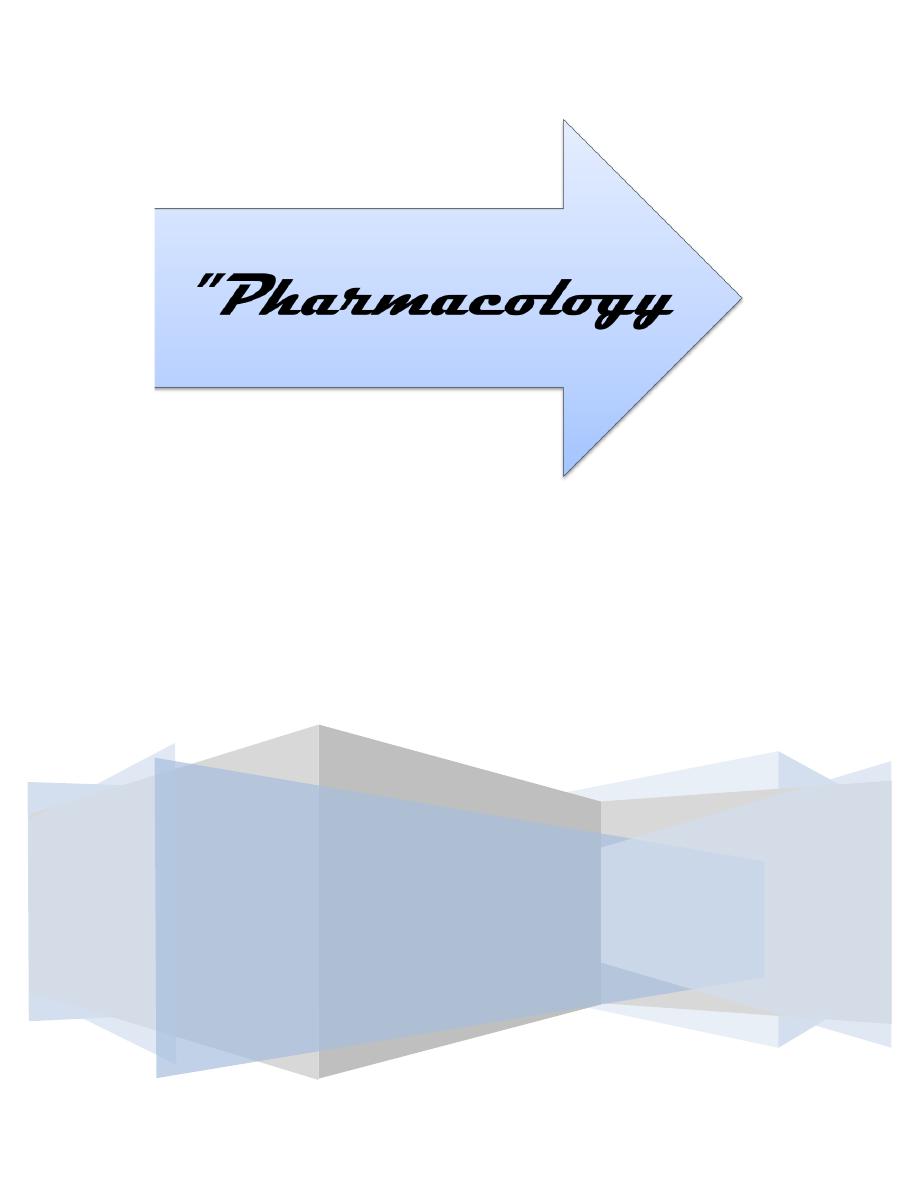
Sunday 26/ 4 / 2015
©Ali Kareem 2014-2015
Name
:
______________________________
Class
:
_______________________________
مكتب اشور لالستنساخ
THYROID & ANTI-
THYROID DRUGS
Lecture 7
Total lectures NO. 58
Dr. Najeeb

Thyroid & Antithyroid
Drugs
The thyroid secretes 2 types of hormones: iodine-containing
amino acids (thyroxine and triiodothyronine) and a peptide
(calcitonin)..
1---- THYROID HORMONES
Synthesis and Transport of Thyroid Hormones
The thyroid secretes 2 iodine-containing hormones: thyroxine (T4)
and triiodothyronine (T3). The iodine necessary for the synthesis
of these molecules comes from food or iodide supplements.
Iodide ion is actively taken up by and highly concentrated in the thyroid
gland, where it is converted to elemental iodine by thyroidal
peroxidase . The protein thyroglobulin serves asa scaffold for thyroid
hormone synthesis. Tyrosine residues in thyroglobulin are iodinated to
form monoiodotyrosine (MIT) or diiodotyrosine (DIT) in a process known
as iodine organification.
Within thyroglobulin, 2 molecules of DIT combine to form
T4, while 1 molecule each of MIT and DIT combine to form T3.
Proteolysis of thyroglobulin liberates the T4 and T3, which are
then released from the thyroid.
After release from the gland, T4 and T3 are transported in the blood by
thyroxine-binding globulin, a protein synthesized in the liver.
Thyroid function is controlled by the pituitary through the
release of thyrotropin (thyroid-stimulating hormone [TSH] and by the
availability of iodide. Thyrotropin stimulates the uptake of iodide as well as
synthesis and release of thyroid hormone.
It also has a growth-promoting effect that causes thyroid
cell hyperplasia and an enlarged gland (goiter). High levels of
thyroid hormones inhibit the release of TSH, providing an effective
negative feedback control mechanism.
In Graves’ disease, an autoimmune disorder, B lymphocytes produce an
antibody that activates the TSH receptor and can cause a syndrome of
hyperthyroidism called thyrotoxicosis. Because these lymphocytes are not

susceptible to negative feedback, patients with Graves’ disease can
have very high blood concentrations of thyroid hormone at the
same time that their blood concentrations of TSH are very low
.
.
Mechanisms of Action of T4 and T3
T3 is about 10 times more potent than T4. Because T4 is converted
to T3 in target cells, the liver, and the kidneys, most of the effect
of circulating T4 is probably due to T3.
Thyroid hormones bind to intracellular receptors that control the
expression of genes responsible for many metabolic processes.
The proteins synthesizedunder T3 control differ depending on the tissue
involved; these proteins include, for example, Na+/K+-ATPase, specific
contractile
proteins in smooth muscle and the heart, enzymes involved in
lipid metabolism, and important developmental components
in the brain.
Effects of thyroid hormone—
The organ-level actions of the thyroid hormones include normal growth
and development
of the nervous, skeletal, and reproductive systems and control of
metabolism of fats, carbohydrates, proteins, and vitamin
Clinical use—
Thyroid hormone therapy can be accomplished
with either T4 or T3.
Synthetic levothyroxine (T4) is usually the form of choice. T3
(liothyronine) is faster acting but has a shorter half-life and is more
expensive.
Toxicity—
Older patients, those with cardiovascular disease, and those with
longstanding hypothyroidism are highly sensitive to the stimulatory
effects of T4 on the heart. Such patients should receive
lower initial doses of T4
Toxicity is that of thyrotoxicosis which includes :

Warm, moist skin
Sweating, heat intolerance
Tachycardia, increased stroke volume, cardiac output,
and pulse pressure
Dyspnea
Increased appetite
Nervousness, hyperkinesia, tremor
Weakness, increased deep tendon reflexes
Menstrual irregularity, decreased fertility
Weight loss
Exophthalmos (Graves’ disease
(
---------------------------------------------------------------------------------------------------------------------------
--------------------------------------------------------------------------------------------------------------------------
.
2----- ANTITHYROID DRUGS
1. Thioamides
Methimazole and propylthiouracil (PTU) are small sulfur containing
Thioamides that inhibit thyroid hormone synthesis by blocking
peroxidase-catalyzed reactions, iodination of the tyrosine
residues of thyroglobulin, and coupling of DIT and MIT .
Propylthiouracil and, to a much lesser extent, methimazole
inhibit peripheral conversion of T4 to T3
. Because the thioamides do not inhibit the release of preformed thyroid
hormone, their
onset of activity is usually slow, often requiring 4 wk for full
effect.
The thioamides can be used by the oral route and are
effective in young patients with small glands and mild disease.
Methimazole is generally preferred because it can be administered
once per day. However, PTU is preferred in pregnancy because
it is less likely than methimazole to cross the placenta and enter
breast milk.
Toxic effects include
skin rash (common) and
severe reactions (rare) such as vasculitis, agranulocytosis,
hypoprothrombinemia,

and liver dysfunction. These effects are usually reversible
.
2. Iodide Salts and Iodine
Iodide salts inhibit iodination of tyrosine and thyroid hormone
release ; these salts also decrease the size and vascularity
of the hyperplastic thyroid gland.
Because iodide salts inhibit release as well as synthesis of the hormones,
their onset
of action occurs rapidly, within 2–7 d. However, the effects are
transient; the thyroid gland “escapes” from the iodide block after
several weeks of treatment. Iodide salts are used in the management
of thyroid storm and to prepare patients for surgical resection of
a hyperactive thyroid. The usual forms of this drug are Lugol’s
solution (iodine and potassium iodide) and saturated solution of
potassium iodide.
Adverse effects include
rash, drug fever, metallic taste, bleeding disorders, and, rarely,
anaphylactic reactions.
3. Radioactive Iodine
Radioactive iodine (131 I ) is taken up and concentrated in the
thyroid gland so avidly that a dose large enough to severely damage
the gland can be given without endangering other tissues
.
Unlike the thioamides and iodide salts, an effective dose of 131 I
can produce a permanent cure of thyrotoxicosis without surgery.
131 I should not be used in pregnant or nursing women.
4. Anion Inhibitors
Anions such as thiocyanate (SCN−) and perchlorate (ClO4 −) block the
uptake of iodine by the thyroid gland through competitive
inhibition of the iodide transporter. Their effectiveness is unpredictable
and ClO4− can cause aplastic anemia, so these drugs are
rarely used clinically.

5. Other Drugs
A- An important class of drugs for the treatment of thyrotoxicosis is
the β blockers. These agents are particularly useful in controlling
the tachycardia and other cardiac abnormalities of severe thyrotoxicosis.
Propranolol also inhibits the peripheral conversion of
T4 to T3.
B- The iodine-containing antiarrhythmic drug amiodarone
can cause hypothyroidism through its ability to block
the peripheral conversion of T4 to T3
Amiodarone-associated hypothyroidism
is treated with thyroid hormone.
Amiodarone also can cause hyperthyroidism
either through an iodine-induced mechanism in persons
with an underlying thyroid disease such as multinodular goiter
or through an inflammatory mechanism that causes leakage of thyroid
hormone into the circulation.
Iodine-associated hyperthyroidism caused by amiodarone is treated with
thioamides, whereas
the inflammatory version is best treated with corticosteroids.
C- Iodinated radiocontrast media (eg, oral diatrizoate and intravenous
iohexol) rapidly suppress the conversion of T4 to T3 in the
liver, kidney, and other peripheral tissues
.
Done by
Ali Kareem

.
